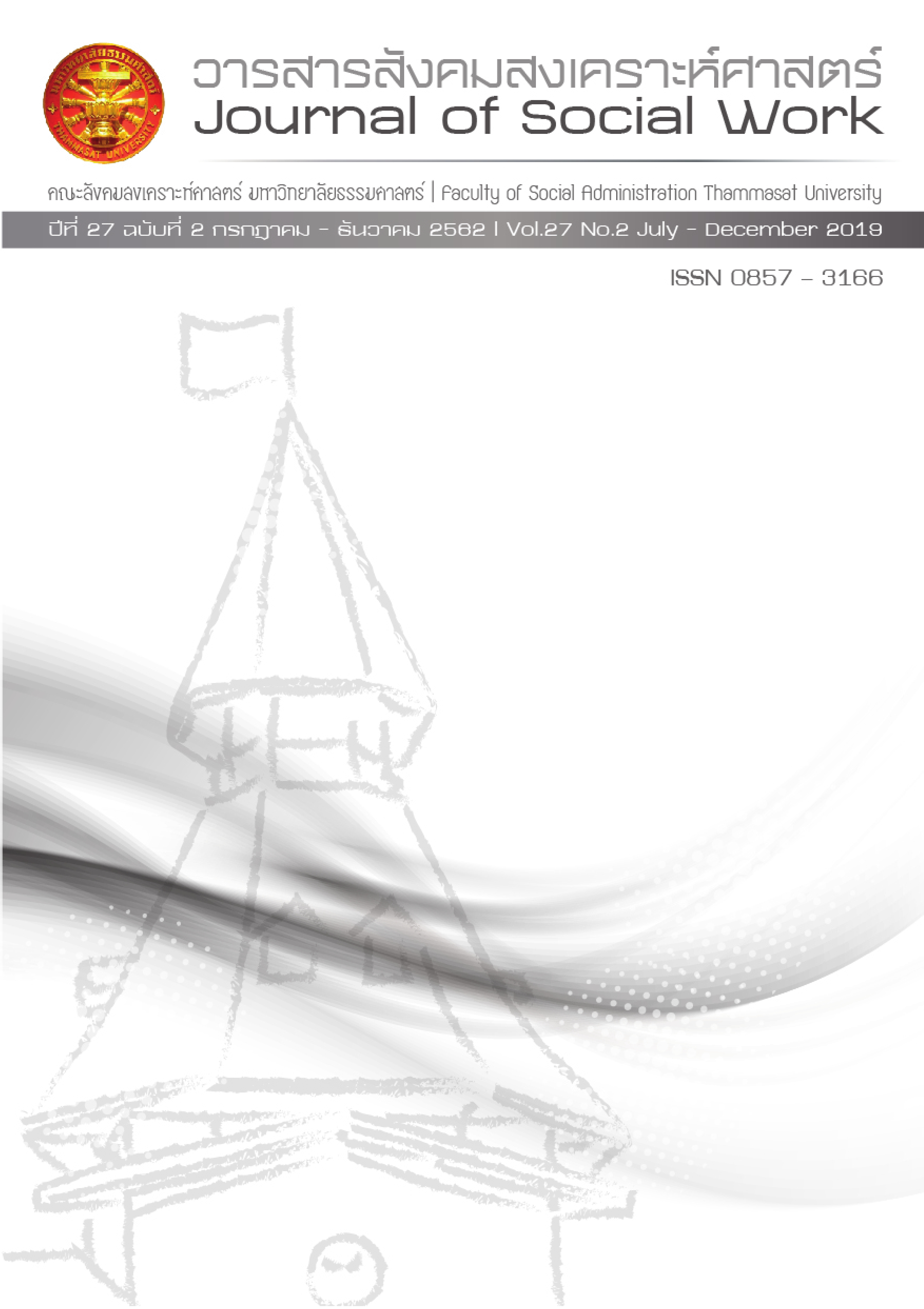The Influence of Online Social Media on Deviant Juvenile Behavior in Bangkok
Keywords:
Online Social Media, Deviant, Deviant Juvenile BehaviorAbstract
This research aims to study the influence of social media on the behavioral deviation of children and youth in Bangkok area. The research objectives were to study the influence of social media on the behavioral deviation of children and youth, and to study the influence of social media on the behavior of children and adolescents, In this study, questionnaires were used to collect data from the population. Samples were children and youth studying in secondary schools in Bangkok. The number of 400 students from 14 schools were selected randomly using multi-state sampling, simple random sampling, and convenience sampling. Statistics used in the study were inferential statistics such as correlation coefficient, multiple regression analysis, dummy analysis, and logistic regression analysis. Analysis reveals that the strongest influencing factors were the duration of gravity to commit the offence, social media usage, external force, and the frequency of using social media, respectively Moreover, it was found that the gravity to commit the offence, the duration of using social media, and the frequency of social media usage, had positive relationship with the behavioral deviation. In other words, when children and youth frequently used social media and used it for a long time, it would create the gravity to commit the offence.Hence, resulted in a high chance of behavioral deviation. The study also found that external impediments had a negative direction with behavioral deviation.If children and youth had low external impedance, there was a greater chance of deviation. The key to inhibiting behavioral deviation was obtained from the external impediments, including love, warmth from family, friends, the ethics of oneself, and the action which was in accordance with the rules and regulations in society. Care should be generally practiced for all family members. Encouraging children and youth to use the media creatively can reduce the influence of social media on children and youth.
References
ณวิสาร์ จุลเพชร และบุญนิภา เกี้ยวม่าน. (2556). ปัจจัยที่มีความสัมพันธ์กับพฤติกรรมการดื่มเครื่องดื่มที่มีแอลกอฮอล์ของนักศึกษา มหาวิทยาลัยราชภัฏนครศรีธรรมราช. สืบค้นเมื่อวันที่ 20 ธันวาคม 2559. https://race.nstru.ac.th/home_ex/eportfolio//pic/academy/24163542.pdf?1574598974
ธาม เชื้อสถาปนศิริ. (2552). (คลิป) เด็กตบกันเทคโนโลยี สื่อ อาชญากรรมออนไลน์ และการหลอมรวมสื่อ. สืบค้นเมื่อวันที่ 20 ธันวาคม 2559. http://www. matichon.co.th/news_detail.php?newsid=1256043827&grpid=&catid=02
นพดล กรรณิกา และคณะ. (2548). โครงการเฝ้าระวังรักษาคุณภาพอนาคตเยาวชนไทย. สืบค้นเมื่อวันที่ 21 ธันวาคม 2559. http://intranet.prd.go.th/libbase/ view_book.php?book_id=864
นิพนธ์ ดาราวุฒิมาประกรณ์. (2558). วัยรุ่นใช้สื่อออนไลน์อย่างไรในการหาคู่. สืบค้นเมื่อวันที่ 20 ธันวาคม 2559. http://www.ms.ipsr. mahidol.ac.th/Conference XI/Download/Book/447-IPSR-Conference-A03-fulltext.pdf
ปกรณ์ มณีปกรณ์. 2555. ทฤษฎีอาชญาวิทยา. กรุงเทพมหานคร: ห้างหุ้นส่วนจำกัด เอ็ม.ที.เพรส.
ปัญญ์กรินทร์ หอยรัตน์, และปราโมทย์ วงศ์สวัสดิ์. (2560). วัยรุ่นไทยกับการมีเพศสัมพันธ์ก่อนวัยอันควร. วารสารวิทยาลัยพยาบาลพระปกเกล้า จันทบุรี. 28(2), 173-182.
ปิยวัฒน์ เกตุวงศา และศุทธิดา ชวนวัน. (2558). ใครเป็นใครบนเครือข่ายสังคมออนไลน์: ความหลากหลายทางคุณลักษณะและพฤติดรรม. สืบค้นเมื่อวันที่ 20 ธันวาคม 2559. http://www.ms.ipsr.mahidol.ac.th/ConferenceXI/Download/ Book/447-IPSR-Conference-A02-fulltext.pdf
พรชัย ขันตี, กฤษณพงศ์ พูตระกูล และจอมเดช ตรีเมฆ. (2558). ทฤษฏีอาชญาวิทยา: หลักการ งานวิจัยและนโยบายประยุกต์. กรุงเทพมหานคร: ส.เจริญการพิมพ์.
มหาวิทยาลัยสุโขทัยธรรมาธิราช. (2554). เอกสารประกอบการสอนชุดวิชา ความรู้เบื้องต้นเกี่ยวกับสื่อมวลชน. นนทบุรี: สำนักพิมพ์มหาวิทยาลัยสุโขทัยธรรมาธิราช.
ศาลาสี่มุม. (2548). อาชญากรไร้เดียงสา. สืบค้นเมื่อวันที่ 21 ธันวาคม 2559. https://blogazine.pub/column-archives/node/864
สถาบันสุขภาพเด็กและวัยรุ่นราชนครินทร์. (2558). จิตรเวชศิริราช DMS 5. กรุงเทพมหานคร: คณะแพทยศาสตร์ศิริราช.
สำนักงานคณะกรรมการเฝ้าระวังวัฒนธรรม. (2549). การเฝ้าระวังพฤติกรรมเสี่ยงเด็กไทย พ.ศ. 2549. วารสารวิทยาลัยพยาบาลพระปกเกล้า จันทบุรี, 28(2).
สำนักงานพัฒนาธุรกรรมทางอิเล็กทรอนิกส์ (องค์การมหาชน). (2559). รายงานผลการสำรวจพฤติกรรมผู้ใช้อินเตอร์เน็ตในประเทศไทย 2559. สืบค้นเมื่อวันที่ 24 สิงหาคม 2559. https://www.etda.or.th/publishing-detail/thailand-internet-user-profile-2016-th.html
อัญชิสา ปงคำเฟย. 2547. การขัดเกลาทางสังคมกับพฤติกรรมเบี่ยงเบนของวัยรุ่นในสถาบันอุดมศึกษา. วิทยานิพนธ์ปริญญาศิลปศาสตรมหาบัณฑิต. มหาวิทยาลัยนเรศวร. พิษณุโลก.
Daniel G. (1956). Criminality theories and behavioral images. American Journal of Sociology. (61). 433-444.
Positionin. (2015). Facebook VS YouTube ศึกนี้นักการตลาดจะเลือกใคร?. 20 ธันวาคม 2559. https://positioningmag.com/61170
Taro Yamane. (1967). Taro Statistic: An Introductory Analysis. New York: Harper
Published
How to Cite
Issue
Section
License
The manuscripts published in the Social Work Journal is the copyright of the Social Work Journal, Thammasat University
Any article or opinion appeared in the Social Work Journal will solely be under the responsibility of the author The Faculty of Social Administration, Thammasat University and the editors do not need to reach in agreement or hold any responsibility.



